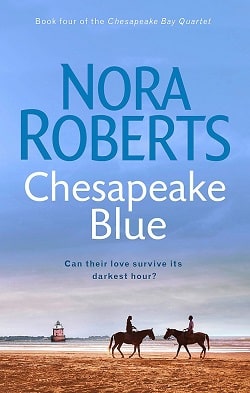Nora Roberts, a master storyteller renowned for her ability to weave intricate tales of romance and family, delivers yet another compelling narrative in Chesapeake Blue, the fourth installment of the Chesapeake Bay Saga. This novel not only revisits the beloved Quinn family but also introduces new dimensions to their saga, focusing on Seth Quinn, the youngest member of the family, as he returns home to Maryland's Eastern Shore. With its rich tapestry of themes, character development, and emotional depth, Chesapeake Blue is a testament to Roberts' storytelling prowess.
The novel opens with Seth Quinn's return to St. Christopher's, a place that holds both the warmth of family and the shadows of his troubled past. Seth's journey is one of transformation, from a boy scarred by his mother's neglect and addiction to a successful painter who has found his place in the world. Roberts skillfully portrays Seth's internal struggles and growth, making him a relatable and deeply human character. His return is not just a homecoming but a confrontation with the past, as he seeks to reconcile his childhood traumas with the man he has become.
One of the most compelling aspects of Chesapeake Blue is its exploration of family dynamics. The Quinn family, with its blend of love, loyalty, and occasional chaos, serves as the emotional core of the novel. Roberts excels at depicting the bonds between Seth and his brothers—Cam, Ethan, and Phil—each of whom has played a pivotal role in shaping Seth's life. The interactions among the Quinns are filled with warmth and humor, providing a sense of continuity and belonging that is both comforting and inspiring.
In addition to family, the novel delves into themes of trust and redemption. Seth's relationship with Dru Whitcomb Banks, a newcomer to the town, is central to the narrative. Dru, a city girl with a desire for independence, is a well-crafted character whose own past has left her wary of deception. The chemistry between Seth and Dru is palpable, and their romance unfolds with a blend of tension and tenderness. Roberts captures the nuances of their relationship, highlighting the challenges they face as they navigate their respective pasts and the secrets that threaten to unravel their newfound love.
The theme of trust is particularly poignant in Chesapeake Blue. Both Seth and Dru must confront their fears and insecurities to build a relationship based on honesty and mutual respect. Roberts handles this theme with sensitivity, illustrating how trust is both fragile and essential in any meaningful relationship. The novel's exploration of trust is not limited to romantic love but extends to familial bonds and friendships, reinforcing the idea that trust is the foundation of all human connections.
Another significant theme in the novel is the concept of redemption. Seth's journey is one of redemption, not only in terms of his personal growth but also in his efforts to protect his family from the shadows of his past. The threat of blackmail looms large, adding an element of suspense to the narrative. Roberts expertly weaves this subplot into the larger story, creating a sense of urgency that propels the plot forward. The resolution of this conflict is both satisfying and thought-provoking, underscoring the novel's message that redemption is possible, even in the face of seemingly insurmountable obstacles.
Roberts' writing is characterized by its vivid descriptions and attention to detail, bringing the setting of St. Christopher's to life. The small seaside town, with its charming shops and picturesque landscapes, serves as a backdrop for the unfolding drama. Roberts' ability to create a sense of place is one of her strengths, and in Chesapeake Blue, she captures the essence of the Eastern Shore with authenticity and affection.
In comparison to other works by Roberts, Chesapeake Blue stands out for its focus on the complexities of family and the enduring power of love. While Roberts has explored similar themes in her other series, such as the In the Garden trilogy and the Bride Quartet, the Chesapeake Bay Saga is unique in its emphasis on brotherhood and the bonds that transcend blood. The Quinn family is a testament to the idea that family is not defined solely by biology but by the love and commitment shared among its members.
For readers who enjoy stories of romance, family, and personal growth, Chesapeake Blue is a must-read. Roberts' ability to craft multidimensional characters and engaging narratives ensures that the novel resonates on both an emotional and intellectual level. The themes of trust, redemption, and the enduring power of love are universal, making the novel accessible to a wide audience.
In conclusion, Chesapeake Blue is a beautifully written novel that captures the essence of what it means to come home. Through Seth Quinn's journey, Nora Roberts explores the complexities of family, love, and the human spirit. The novel is a fitting conclusion to the Chesapeake Bay Saga, offering readers a satisfying and heartfelt story that lingers long after the final page is turned. Whether you are a longtime fan of Roberts or new to her work, Chesapeake Blue is a testament to her skill as a storyteller and her understanding of the human heart.
























Reviews 0
Post a Reviews: